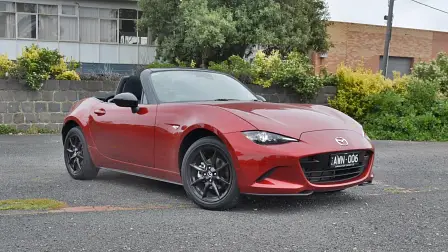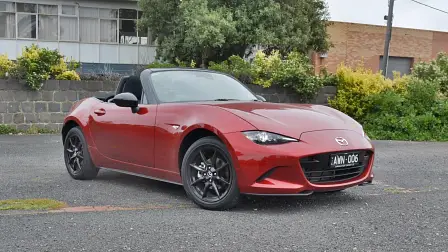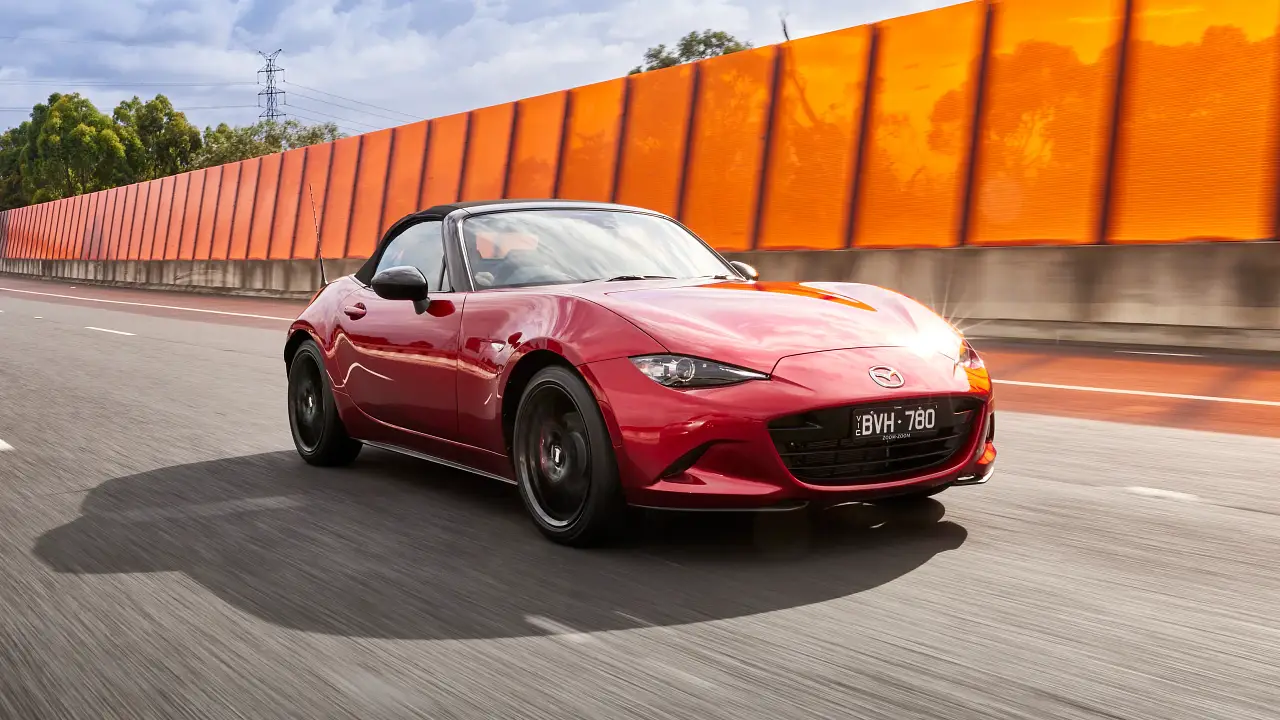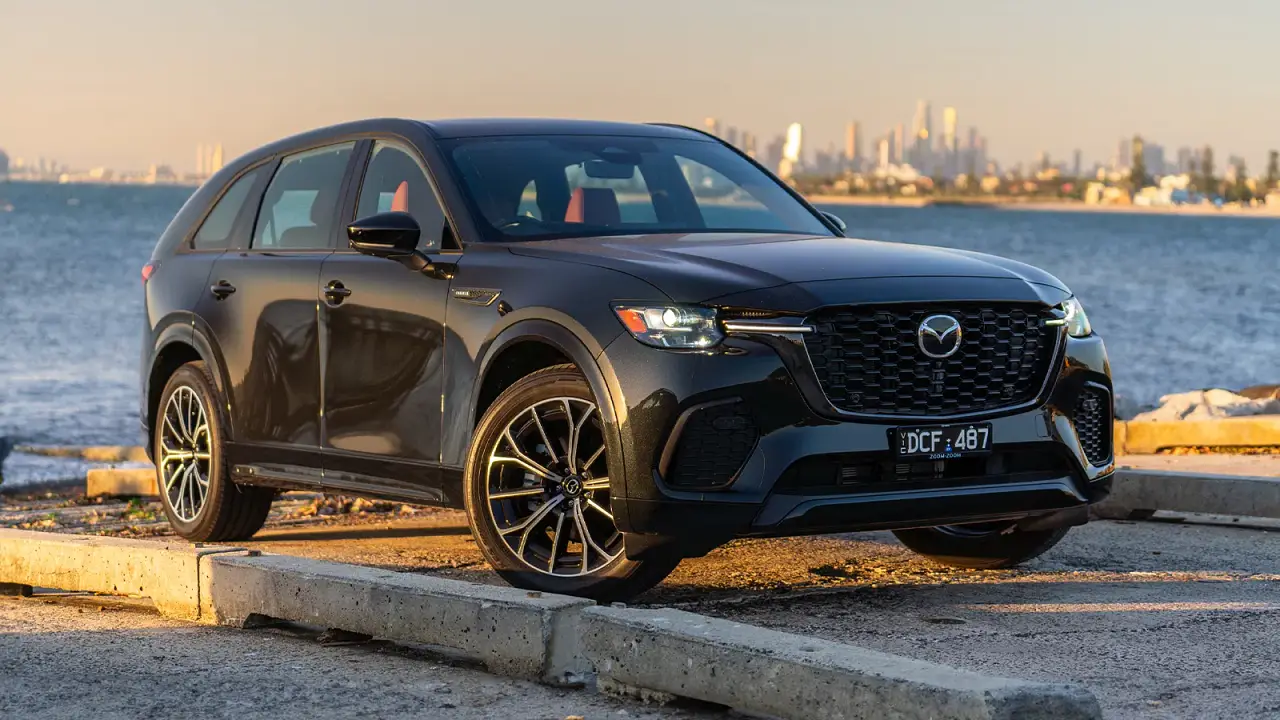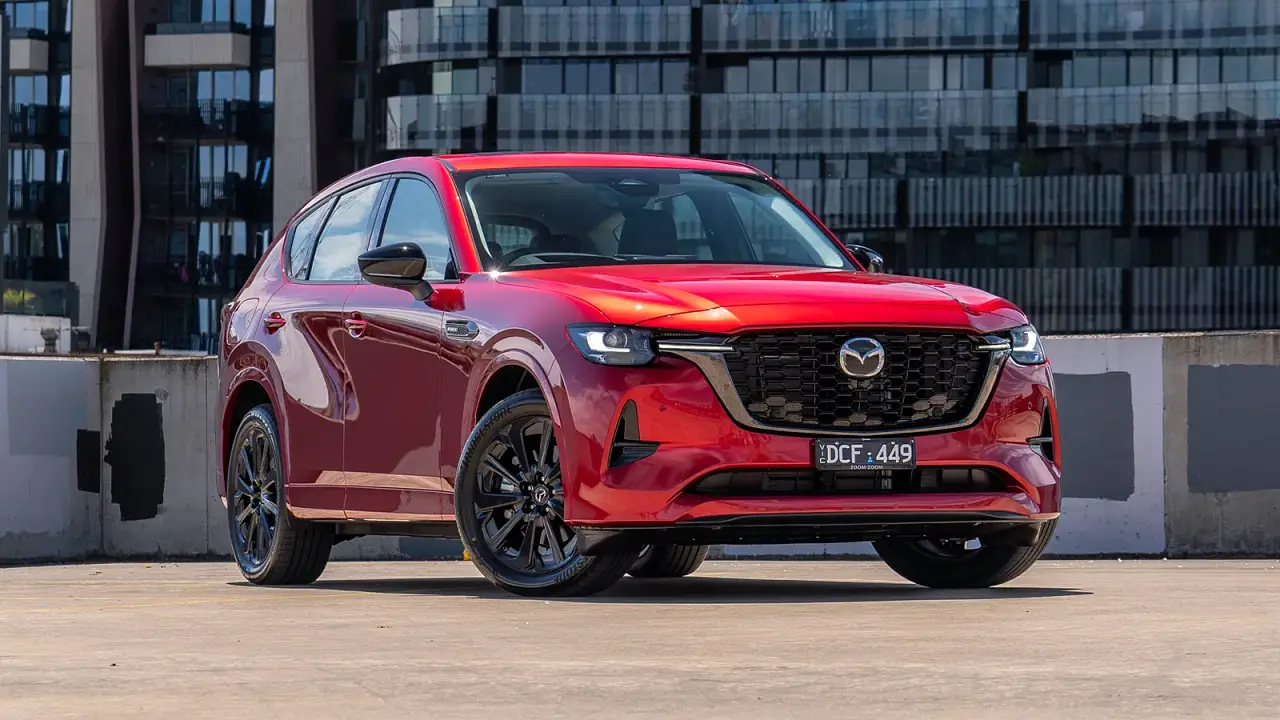- Doors and Seats
NA
- Engine
NA
- Engine Power
118kW, 200Nm
- Fuel
Petrol 6.9L/100KM
- Transmission
NA
- Warranty
NA
- Ancap Safety
NA
2018 Mazda MX-5 Roadster review
Whether purists want it or not, it was bound to happen.
The 2018 Mazda MX-5 Roadster scores extra safety technology, new cabin appointments and a higher pricetag than before.
Refreshingly in a world where cars are getting larger, bloated with more ‘stuff’ inside them, the new-for-2015 ND-generation of the world’s top-selling roadster stripped back the layers to become smaller and lighter.
Where other (said larger) rivals are combatting stricter global emissions regulations by utilising downsized engines then adding clever low-pressure turbocharger technology to quite literally boost outputs where required, Mazda lobbed in a 1.5-litre base engine … sans turbo.
As tested here, this entry engine is still the tiniest engine ever featured in the model’s 30-year (as of 2019) history, simply because the roadster is so tiny. Yet this latest update becomes $2300-pricier than three years ago, and a bit heavier as well. So is this MX-5 a better MX-5?
Vehicle Style: Sports car
Price: $34,190 plus on-road costs
Engine/trans: 97kW/152Nm 1.5-litre 4cyl | six-speed manual
Fuel Economy Claimed: 6.2 l/100km Tested: 7.8 l/100km
OVERVIEW
It was priced from $31,990 plus on-road costs three years ago, but today’s MX-5 Roadster kicks off from $34,190 (plus orc). Compared with 2015, though, this 2018 model does score a 7.0-inch touchscreen, digital radio, satellite navigation with voice control, a rear-view camera, blind-spot monitor and low-speed autonomous emergency braking (AEB).
That’s a fair whack, to be fair, and yet the former 1009kg kerb weight has only edged up to 1021kg. Also to be fair, the 1.5-litre naturally aspirated four-cylinder engine only creeps up 1kW/2Nm to 97kW of power at 7000rpm and 152Nm of torque at 4500rpm.
A potential pricing problem emerges, however, given that at its 2015 launch the optional 2.0-litre naturally aspirated four-cylinder engine asked $34,990 (plus orc), offered a gruntier 118kW/200Nm, still only weighed 1033kg and even added the 7.0-inch screen. So now you’re getting more stuff, but less grunt, for just an $800 saving compared with before…
It’s not as though you can still buy the bigger engine for $35K, though. The latest facelift has focused on raising that its redline from 6800rpm to 7500rpm (to match the 1.5-litre – previously a core reason to buy the little engine), and outputs to 135kW/205Nm. But that pumped-up unit is now available as an MX-5 Roadster GT only, with 17-inch alloy wheels (up from 16s), keyless auto-entry, leather/heated seats, Bose audio, lane-departure warning, rear parking sensors and reverse AEB, all for a hefty $41,960 (plus orc).
THE INTERIOR | RATING: 3.5/5
Standard Equipment: Remote central locking, automatic on/off headlights and wipers, leather-wrapped steering wheel and handbrake lever, cruise control, single-zone climate control air-conditioning, and power windows and mirrors.
Infotainment: 7.0-inch touchscreen with Bluetooth connectivity, twin USB ports, Apple CarPlay/Android Auto smartphone mirroring, digital radio and satellite navigation.
Options Fitted: None.
Cargo Volume: 130 litres.
Despite price rises and trim shuffles, the MX-5’s cabin has never looked or felt better for bang-on $34K. Mazda has finally added a reach-adjustable steering wheel as standard across the range, replacing the previous tilt-only system, and it makes for a better driving position.
There are also redesigned cupholders, and apparently easier-to-close doors, but the best changes really are the equipment additions. Three years ago, an entry-level buyer scored a single-DIN dot-matrix radio with poor connectivity, and now there’s an excellent system complete with nav, good voice control, digital radio and Apple CarPlay/Android Auto smartphone mirroring technology – must haves for the must-have generation.
The knurled-silver climate controls, previously reserved for the GT, are a further touch that lifts the cabin ambience, and likewise the colour trip computer screen within the speedometer and tachometer cluster – where previously it was a black-and-white screen.
Inexplicably, though, there’s still no digital speedometer. There’s clear space for it within the speedo, but the secondary square screen is used as a ‘shift suggestion’ display, for models with a manual transmission at least.
Otherwise, the basic, black plastics and basic, grey cloth trim remain. However, jumping from this $34K MX-5 Roadster to the $42K MX-5 Roadster GT still buys cool-looking colour-coded upper-door trims, leather inserts for the doors, as well as leather on the seats, which makes for an even more upmarket ambience than in this entry-level model grade.
In either case there’s surprisingly decent storage, with a lockable bin and cupholders behind the seats, a tray for keys in the centre console, a pocket for a smartphone under the climate controls, and door bottle holders as well.
The seats are not the most supportive buckets to be found in a sports car, though, and indeed its two-door hard-top Toyota 86 rival shows the way forward with wider chairs and extra side bolstering, plus a lower seating position that feels racier.
Conversely, however, the Mazda MX-5 is a smaller, more intimate car (as well as weighing over 200kg less…) complete with a shallow dashboard and more upright forward pillars, and that pays other dividends for those who simply don’t need to take up more space on the road.
It also means there’s no need for weighty electronics to lift the overhead fabric roof back. Simply manually unlatch the roof with one clip, then pull it back with one arm (it’s light enough even for a journalist who is hardly tradie-tough) and push it down slightly to hold.
Speaking of manual, there’s a traditional manual handbrake perfect for those like me who have never understood why pulling up a lever was seen to create so much physical exertion that it needed to be replaced by an electronic button, as per most cars. It’s a pox avoided here.
What can’t be avoided is the teeny-tiny boot volume. At 130 litres, it’s about half as big as a small hatchback’s and will fit a couple of weekend bags and that’s it.
ON THE ROAD | RATING: 4.0/5
Engine: 97kW/152Nm 1.5-litre petrol 4cyl.
Transmission: Six-speed manual transmission, RWD.
Suspension: MacPherson strut front and independent rear.
Brakes: Ventilated front and solid rear disc brakes.
Steering: Electrically assisted mechanical steering.
To big or not too big? That is the question that has faced ND-gen MX-5 buyers. Now that there’s such a yawning pricing gap between 1.5- and 2.0-litre four-cylinder engines, it might be as clear-cut as someone being able to afford a sub-$35K versus $40K-plus roadster, although Mazda claims a staggering 95 per cent of buyers will choose the larger engine.
So, are buyers silly to be size queens? Well, yes and no. In isolation this engine is such a smooth, sweet and energetic unit. It revs with seemingly unending fervour to 7500rpm, backed by crisp throttle response and an utterly superb manual shift (bought by 57 per cent of people – the remainder will pay $2000 extra in all cases for a six-speed automatic gearbox).
There’s instantly sharp steering response, supported by a body that feels incredibly tight and a chassis light and agile on its feet. Whether around town or on a twisting country road, there’s an alertness and fizzy flavour to this ‘baby’ MX-5 that pricier sports cars can’t match.
Yet on 16-inch tyres it rides brilliantly, skimming and floating over road irregularities with almost a luxurious air. That is until a sizeable undulation is hit and it displays brilliant body control as well. Not any hot hatchback can deliver such exotic ride/handling.
This Mazda can be driven precisely and smoothly, with a driver needing to keep cornering speeds up and revs high to make progress that would humble several big-engined sports cars. There’s a daintiness to the way it tips its nose into bends, then hunkers at the rear on exit.
Yet it also loves being grabbed by the scruff of its neck, and this is the best way to get around the problem of power. Tip the ‘Mixxer’ aggressively into a bend and the weight balance very obviously shifts to the rear, begging the driver to apply early throttle. Rather than needing to move its rump on the throttle, which it struggles to do with such limited power, a driver is now using the engine to just hold an understeer-erasing, neutral cornering attitude. Super!
Yet after such hilarity, the trip computer displays 7.8 litres per 100 kilometres. Around town or on a freeway cruise, sub-7L/100km is all too easily achieved.
So, then, what are the problems? Well, whichever the engine, it could use a Sport mode of electronic stability control (ESC), which Toyota has masterfully integrated into its 86 coupe.
And to the question of 1.5- versus 2.0-litre, there’s no doubt with the latter, larger engine you’re gaining broader dynamic ability. Hillclimbs are called just that for a reason, and any time corners are pointing upwards, this MX-5 Roadster just runs out of steam. It needs 35 per cent more power – which the MX-5 Roadster GT now offers up…
SAFETY
ANCAP rating: 5-Stars – the Mazda MX-5 scored 35.20 out of 37 possible points when tested by ANCAP in 2016.
Safety Features: Dual front and front-side airbags, ABS, ESC, low-speed autonomous emergency braking (AEB), blind-spot monitor and reverse-view camera.
WARRANTY AND SERVICING
Warranty: Five years/unlimited km
Servicing: Mazda offers a capped-price service program, with annual or 10,000km intervals amounting to $1580 over four years or 40,000km.
RIVALS TO CONSIDER
The Abarth is the MX-5’s Italian near-twin, but with a raspier and faster turbocharged four-cylinder, it’s a more overt flavour to the Mazda’s purist, undiluted dynamic appeal.
An updated 86 GT, when equipped with the optional Performance Pack that includes Sachs dampers and Brembo brakes, now trumps this roadster for overall steering and handling finesse – although fun factor is closer, and the Toyota feels larger and weightier. Which it is.
Choose its near-twin BRZ for the above reasons, but it gets Apple CarPlay/Android Auto to match the model tested here – where the above model misses out on it.
- Abarth 124 Spider
- Toyota 86 GT
- Subaru BRZ
TMR VERDICT | OVERALL RATING: 4.0/5
The MX-5 Roadster is now a more complete entry-level model grade than before, simply because it doesn’t force buyers of the base two-door to accept an inferior stereo and hollowed-out cabin.
Mazda arguably needed to listen to modern requirements, too, and it should be applauded for adding AEB, blind-spot and other safety gear as standard – where the Toyota 86 and Subaru BRZ still lack that technology, despite being even older.
The ND-gen was all about lightness and attainability, though, and we can’t shake the feeling that a near-new pre-facelift 2.0-litre (which was $35K new) would be preferable to this brand new, facelifted 1.5-litre at $35K.
Knowing that there’s even more power, torque and revs on offer in the revised version of the bigger engine is a tantalising prospect, and along with the more premium cabin buyers are clearly prepared to pay for it. In this case bigger really is better.
